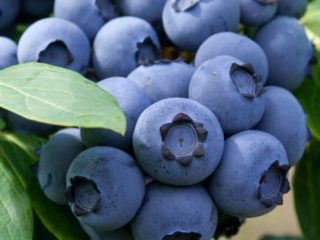Content
Erliblue blueberries are a variety of berries that are distinguished by their early ripening, pleasant taste and content of a large number of useful substances. The variety was included in the State Register of the Russian Federation in 2005, distributed not only in Russia, but also in Belarus. It first appeared in North America in the middle of the last century.
Description of Erliblue blueberry
Erliblue blueberry is a medium-growing variety. The main varietal characteristics of the crop are early fruiting, resistance to frost and powdery mildew.
Features of fruiting
The Erliblue variety is self-fertile. Therefore, it needs cross-pollination. To do this, it is necessary to plant several different crop bushes on the site. The main thing is that the flowering dates of the selected varieties coincide (early July), this will ensure early ripening of Erliblue blueberries and improve the quality and quantity of fruits.
Blueberry stems have a reddish tint and grow up to 2 meters in height.The bushes do not form a large number of shoots, therefore they do not require constant pruning and thinning. The crop is also grown as an ornamental plant.
The fruits of the bush have a sweet-sour taste and contain a large amount of vitamins. During a season, you can collect about 5 - 7 kg of berries from a bush, and with special care the figures can reach 9 - 10 kg. The berries themselves weigh about 2 g, but do not fall off even when fully ripe.
The shelf life of the fruit is low - no more than 20 days, so the berries do not tolerate long-term transportation. In this regard, after harvesting, it is preferable to process or freeze the berries.
Advantages and disadvantages
Erliblue garden blueberry is a storehouse of vitamins and beneficial microelements, as well as a berry with excellent taste. But it also has its advantages and disadvantages.
Among the positive features of the variety are the following:
- early maturation;
- pleasant taste;
- frost resistance;
- ease of care;
- immunity to powdery mildew.
The disadvantages include:
- picky attitude to soil quality;
- low level of transportability of berries;
- extended period of fruit ripening.
Features of reproduction
The blueberry variety Erliblue can be propagated by cuttings, seeds and layering. Seed propagation is not used in summer cottages, as it is a rather labor-intensive and time-consuming process.
Layerings are also rarely used for propagation, only if you have experience in breeding the variety in a similar way.
Cuttings are the main method of blueberry propagation. Shoots suitable for planting grow from buds formed on semi-lignified and woody cuttings.
Woody cuttings must be prepared in winter by collecting several branches in a bundle.They must be stored in a cellar or refrigerator.
Semi-lignified branches are cut off in mid-summer, after which they are immediately planted in the soil, using watering with special preparations that stimulate growth.
Planting and care
Erliblue low-growing blueberry is a variety that is distinguished by its unpretentiousness. The main rule of cultivation is proper planting of the crop.
Recommended timing
The best time to plant Erliblue blueberries is spring and autumn. Before planting in any season, it is recommended to soak the seedlings in water so that they can be saturated with moisture for 10 - 20 minutes. After this, the root system should be slightly stretched. All this helps to saturate the roots with oxygen.
Site selection and soil preparation
In order for the seedlings to take root well, it is necessary to select high-quality soil for them. Erliblue is a blueberry that prefers soil whose acidity ranges from 3.5 to 4.5 pH. To impart the required acidity, peat, sawdust, foliage and other materials are used.
Erliblue does not tolerate high moisture, so the variety should not be planted in wetlands and on clay soils. If water stagnates in the soil, the blueberry roots will begin to rot and die.
Erliblue prefers sunny places, but the shade can cause a decrease in yield and nutrients in the berries.
Landing algorithm
Planting of seedlings is carried out in prepared holes, the width and depth of which is 50 cm, and the distance between them is at least 1.5 meters. They are filled with a substrate with the required level of acidity.
Planting blueberries can be done in a variety of ways.
The first option is to the ridge:
- It is necessary to dig a trench 10 cm deep and 100 cm wide.
- Pour the substrate into it to form a small mound.
- Plant a blueberry bush.
- Water.
The second option is wells:
- Make a trench or hole, the width of which will be at least 80 cm and the depth - 40 cm.
- Pour the prepared substrate there flush with the soil.
- Plant blueberries.
- Shed.
The third option is containers:
- Prepare a special container (plastic and wooden containers can be used).
- Make several holes in it.
- Cover with suitable soil.
- Dig the container into the ground (you can not deepen the container completely, the main thing is that it is stable).
- Plant a blueberry bush.
- Water.
Planting Erliblue in containers is preferable because it is easier to provide the plant with the right quality soil.
Growing and care
In order for Erliblue blueberries to look no worse in a summer cottage than in the photo, they need to be grown correctly. The crop needs fertilizing, regular watering, pest control and rare pruning.
Watering schedule
Since the yield of Erliblue blueberries depends entirely on the level of moisture in the soil, watering must be taken responsibly. The variety does not like stagnation of moisture at the roots, but does not tolerate drought well. Therefore, the shrub watering schedule must be strictly followed.
Experienced gardeners recommend watering shrubs twice a week. Moreover, every day there are two waterings - in the morning and in the evening. The amount of water is determined by the condition of the soil and the amount of precipitation. The average volume for each bush is 1 bucket at a time.
Feeding schedule
Fertilizing is one of the most important factors in growing blueberries, since the crop is demanding on soil acidity and can die if the required standards are not met. This variety must be fertilized according to a specific schedule:
- Mineral fertilizers are applied in the spring.
- Nitrogenous preparations are added in June, July and August.
- Phosphorus is applied in mid-summer and early autumn.
The main signs that a plant needs soil acidification are yellowing and dry foliage. The situation can be changed either with specialized preparations or by adding sulfur powder, ammonia, and citric acid (25 g per 5 liters of water) to the soil.
Trimming
The variety does not require annual pruning. To maintain the health of the bush, sanitary treatment is carried out, starting only from the 3rd year of blueberry life. To do this, dry and diseased bushes are removed. To make it more decorative, you can cut off root growths.
Preparing for winter
Since one of the distinctive features of Erliblue blueberries is that they are varieties with a high level of frost resistance, the crop does not require special preparation before winter.
The only exceptions are regions where the climate is considered harsh, and frosts reach -40 degrees. In this case, it is recommended to erect a bush shelter. For this, bark or pine needles and non-woven fiber are used.
Pests and diseases
Among the diseases to which blueberries of this variety are susceptible, there are both fungal and viral pathologies:
- mummification of berries;
- gray rot;
- black spot;
- stem cancer;
- anthracnose
Among pests, most often the only enemies of the crop are birds, from which the bush simply needs to be covered with a net.
To prevent the development of diseases, it is necessary to use special preparations that are used to treat blueberries at the very beginning of spring.
Conclusion
Erliblue blueberries are a variety that can delight you with juicy, delicious berries already in July. At the same time, the berries do not require special care. The main thing is to follow the planting rules, monitor the acidity of the soil and water and fertilize the crop in a timely manner.











